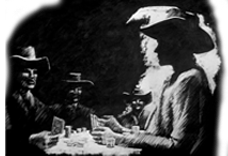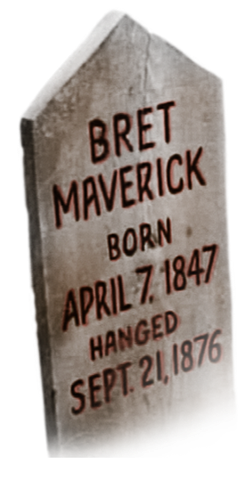







Unlike most episodic television, Maverick was largely an "anthology" series. Having no real fixed cast from episode to episode, the Mavericks moved from place to place seemingly every week. This allowed a wide variety of stories to be told. The principle characters could change with every episode. Good guys and bad, sweethearts and femmes fatale... could come or go, live or die. It never mattered the following week, when the events of the last story were left far behind us.
Or were they far ahead of us? Maverick didn't do something else that most other episodic series did... follow a continuous timeline. Although often unmentioned in most series, it was generally assumed that one week's story followed the last, in a more-or-less linear chronology. Not so with Maverick. Not by a longshot.
This rarely mattered to the Chroniclers of Maverick. They were simply telling "western" stories. Placing any script in the 1870s or '80s was close enough. In the days before ubiquitous series syndication or home video recorders, it didn't matter much to the viewer. Details of last week's episode were quickly and easily forgotten, so chronological continuity seemed unimportant.
For instance, the pilot episode of Maverick, "War of the Silver Kings," was set in 1870, the year clearly shown on a telegram. Two episodes later, "According to Hoyle" is set no earlier than 1876, based on the publishing date of "Hoyle's Book of Games," which figures prominently in the story. In the very next episode, "Ghost Rider," Bret discovers a week-old grave marker dated 1872. Yet, supposedly twenty years after the original series, Bret and Bart reunite later in life, this time with Cousin Ben, in "The New Maverick." One would logically assume it must be nearly the turn of the century for them, yet the story is clearly set only in 1880. Other episodes aren't as precise with actual dates, but may have specific historic references, such as a young Billy the Kid (notoriously active from 1877 until his death in 1881) showing up in "Full House" (Maverick, 1959) and again during Bret's retirement years in "Anything for a Friend" (Bret Maverick, 1981). We won't even get into Doc Holliday at this point.
Maverick's timeline is a convoluted belt game of events, making sense only on how one chooses to unravel it. However, if we stick strictly to the dates and historic references in the individual stories as presented, regardless of production order or the apparent ages of the actors, a solid Chronology develops. In combination with informed conjectural dates for the more ambiguous stories, a compelling timeline can be established. In so doing, we cut a wide swath through American history and culture, encountering some fascinating side stories along the way. When finally put together into this bigger picture, "the Legend of the West" becomes a much richer Saga than first imagined.
So, enjoy a trip through history in Maverick Trails' chronological order, or leap back and forth across the Mavericks' lifetimes, like a certain Dr. Beckett did during his own. But that's another story.
ABOVE
Bret Maverick's grave marker (Maverick: Season 2 — The Day They Hanged Bret Maverick)
1870s
1870 • War of the Silver Kings
1871 • Trail West to Fury (framing story)
1871 • The Wrecker
1871 • Brasada Spur
1876 • The Jeweled Gun
1871 • The Thirty-Ninth Star
1871 • The Day They Hanged Bret Maverick
1871 • According to Hoyle
1871 • Stampede
1871 • Escape to Tampico
0000 • Relic of Fort Tejon
1800s 1800 1801 1802 1803 1804 1805 1806 1807 1808 1809
1810s 1810 1811 1812 1813 1814 1815 1816 1817 1818 1819
1820s 1820 1821 1822 1823 1824 1825 1826 1827 1828 1829
1830s 1830 1831 1832 1833 1834 1835 1836 1837 1838 1839
1840s 1840 1841 1842 1843 1844 1845 1846 1847 1848 1849
1850s 1850 1851 1852 1853 1854 1855 1856 1857 1858 1859
1860s 1860 1861 1862 1863 1864 1865 1866 1867 1868 1869
1870s 1870 1871 1872 1873 1874 1875 1876 1877 1878 1879
1880s 1880 1881 1882 1883 1884 1885 1886 1887 1888 1889
1890s 1890 1891 1892 1893 1894 1895 1896 1897 1898 1899
1900s 1900 1901 1902 1903 1904 1905 1906 1907 1908 1909

WAYS OF RECKONING
For consistency and credibility, the following system is used by Maverick Trails in ordering the individual stories into its Chronology:
1. Given date. Many stories do us the great favor in providing an exact date. The timeline for the story is then built solidly around it, and may be placed into the Chronology with confidence. This is the prime factor in dating the entire Chronology and, except in very rare cases, trumps all other dating criteria.
2. Historical reference. A story may not give a specific date, but something in context may relate to an actual historic event around which the date may be deduced. Only a given date trumps an historical reference in ordering the Chronology. If real history is referenced, it is not ignored for the convenience of a given story. Any apparent anachronisms must be explained. However, other than a specific historic moment, historic events may cover a broader scope of time, and may therefore be more forgiving to interpretation.
3. Relation to other stories. Occasionally, it is clear that an individual story must take place before or after more reliable events firmly established in other tales. This may lead to apparent conflicts, but is always resolved logically.
4. Geographic reference. Very often, other than there being no motor cars or electrical appliances in a story, there is absolutely no reference to the time of an undefined story's placement into the Chronology. But in most cases, there is a given place. In these cases, if there are no other conflicts, they are placed into a logical sequence in relation to the vicinities of better established story settings. So, if a well-established story takes place in or near Denver, for instance, and another undefined story takes place in or near Denver, it may be assumed that the two might happen within a similar timeframe. For instance, given the time required to travel overland in those days, it would be impractical to be in Denver one week, New Orleans the next, and back in Denver again a month later. Not that the Mavericks didn't make those kinds of trips. They often did. But it is also reasonable to assume an otherwise undefined story, set perhaps in St. Louis, might unfold along that trail.
5. Production order. When all other factors are so general that a story may be considered random, the order in which the studio or publisher produced the stories is used.
6. Age of actors. In general, the age of an actor may be used to judge the apparent age of the character he or she is portraying. Sometimes it may be helpful in gauging when a story might take place. But with the Mavericks in particular, this is often difficult. The most obvious example is the age of James Garner himself as Bret Maverick. We see him as in his thirties in Maverick, and in his fifties in Bret Maverick, a general age difference of about twenty years. Yet, the stories of the original series touch on historical events of the 1870s, well into the 1880s, and sometimes into the 1890s. There are even a very few that most likely happen after the turn of the century. Yet, the entire series Bret Maverick, supposedly set in Bret's later years, takes place in the very early 1880s, and ends there. Clearly, we must assume the age of an actor, even a key one, is not an absolute indication of when a story might take place. An extreme example is that of Doc Holliday, and the three actors that portrayed him throughout the Saga. Gerald Mohr was 43, Peter Breck was 32 and John McLiam was a whopping 63, while Doc Holliday himself died of tuberculosis at age 36. So, Maverick Trails relies first on story content to establish a time setting, and the ages of actors only as a guide when it doesn't conflict with other more reliable factors.
7. Commemorative dates. In order to affix a specific date to an otherwise fictional event, in lieu of other information in a story, the use of an actor's birthday, the original airdate of an episode, or other similar factors may be used to commemorate the day. Such dates are purely conjectural, but important to lend context to the full Chronology.
The use of these criteria in the above order is how Maverick Trails establishes its Chronology. Granted, some of the undefined stories may arguably go in any order, and may be considered interchangeable. But we choose to adhere to a single system for consistency. When applied carefully, and using real history and geography as our guiding rule, the resulting Chronology is solid, and truly reveals Maverick as a Legend of the West.
Home | The Maverick Saga | Trail Maps | Chronology | Maverick Lore | Production | The Inside Straight | Contact Maverick Trails
Maverick Trails is not endorsed, sponsored or affiliated with Warner Bros. Entertainment, Inc. or the Maverick franchise.
Maverick™ and its various marks are trademarks of Warner Bros. Entertainment, Inc., © 1957, 1994
©2014, 2015, 2016 Maverick Trails















